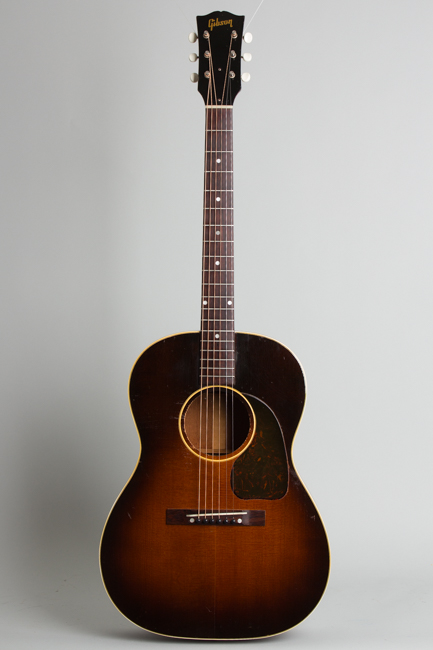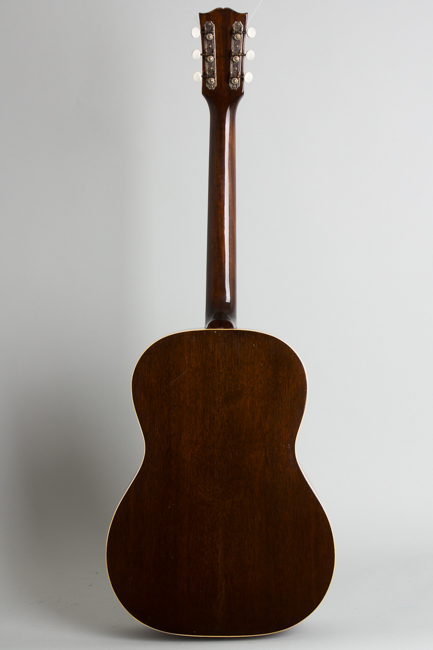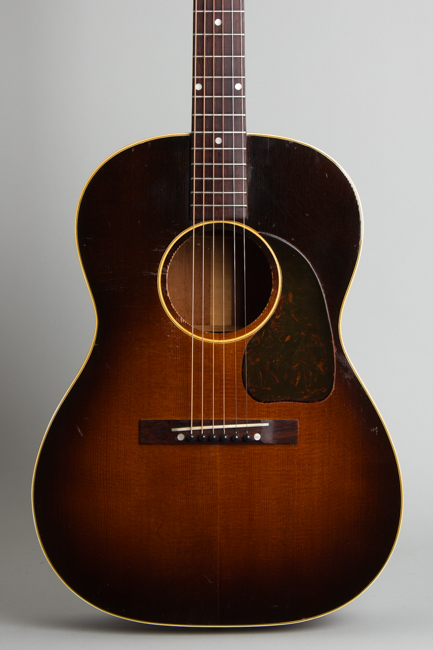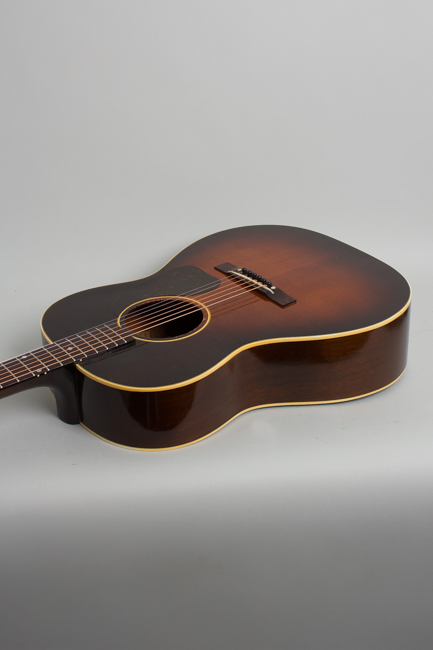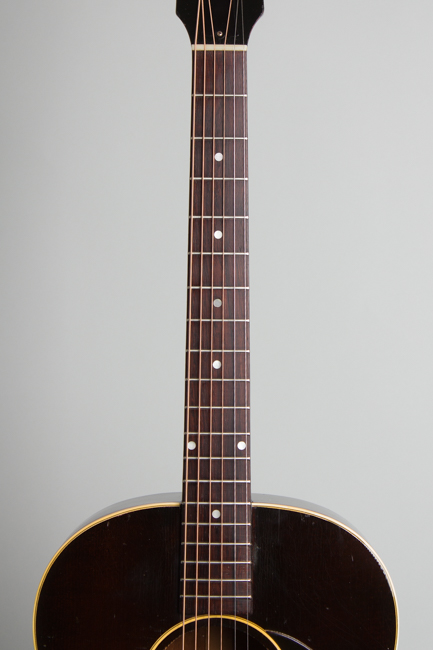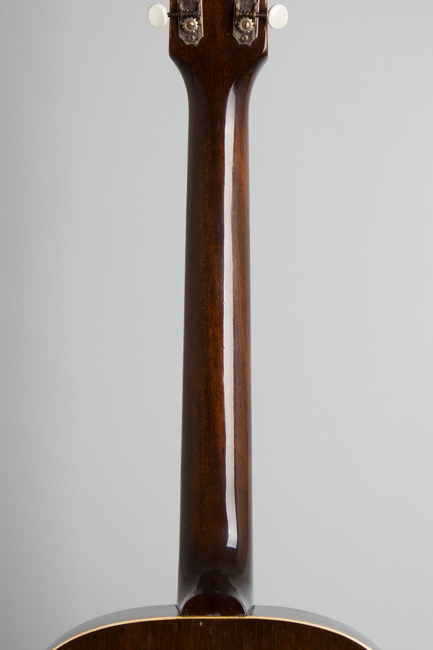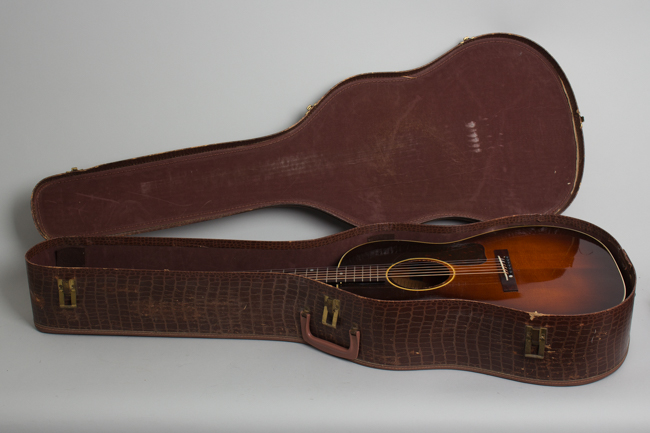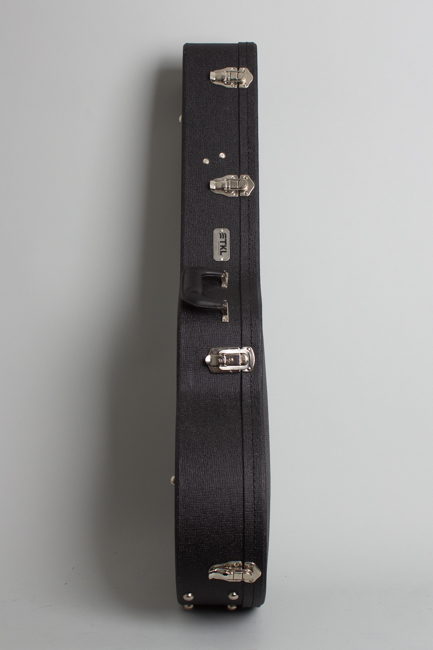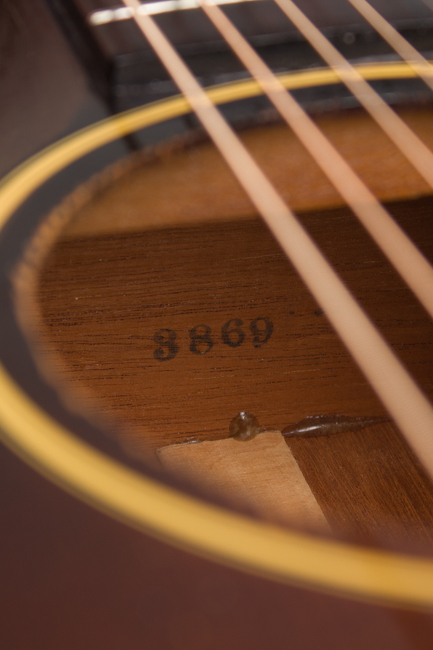Gibson LG-2 Flat Top Acoustic Guitar (1949)
Gibson LG-2 Model Flat Top Acoustic Guitar (1949), made in Kalamazoo, Michigan, serial # 3869 (FON), sunburst top, dark stained back and sides finish, mahogany back, sides and neck, spruce top, rosewood fingerboard, black tolex hard shell case.
This is a nice just post-WWII example of Gibson's popular smaller body flat-top guitar from the 1940s and '50s, the LG-2. It was the middle model of a three-instrument line with the externally identical but ladder-braced LG-1 below it and the natural-finish LG-3 above. From 1948-50 the LG-2 sold roughly 3000 instruments, with well over double that amount of LG-1's shipped. 1949 actually fell below average with 786 shipped. In the early post-war period Gibson's flat tops represented a major part of the company's revenue stream while getting back up to speed after doing mostly war work for 4 years.
The LG-2 has factory order number on the heelblock suggesting the 1949 build year with the block script "modern" logo on the headstock that appeared in 1948. This early version is a decal not a silkscreen. The headstock is tapered in depth, with early post-war Kluson strip tuners fitted. Other period features include a very deep subtle sunburst top finish, dark mahogany back and sides, small tortoise celluloid pickguard, small rectangle bridge and single-bound top and back. The truss-rod equipped neck has a lovely round-backed "C" profile, quite a bit slimmer than the thick wartime "baseball bat" style and very comfortable. This is a smooth, powerful sounding and versatile guitar; generally well preserved and an excellent example of Gibson's early post-war flat-top period.
Overall length is 39 1/2 in. (100.3 cm.), 14 3/8 in. (36.5 cm.) wide at lower bout, and 4 1/2 in. (11.4 cm.) in depth at side, taken at the end block. Scale length is 24 3/4 in. (629 mm.). Width of nut is 1 11/16 in. (43 mm.).
This is a nice example overall, showing not all that much play time considering it was made before the Korean War well over 75 years ago. The original lacquer is still shiny maintaining the original deep color to the sunburst and nice original patina overall. There is some wear to the soundhole rim and a little pick wear off the bottom of the pickguard. Other than this the face shows some pick marks above the strings, dings, scuffs, and other minor marks. The back, sides and back of the neck are really pretty clean with only a couple of small wear spots; the headstock edges show heavier wear and some minor touch ups.
The guitar is remarkably virtually crack free after 7 1/2 decades, showing only a tight re-seal to the top seam. The neck has been reset neatly and retains the original small-wire frets showing only light wear. The original rosewood bridge has been lowered and visibly reglued, with some touch up along the perimeter and fitted with a new saddle. The original bracework and small maple bridgeplate are fully intact, with some brace re-glues visible as is typical for older Gibsons. The original openback tuners have been re-buttoned. This is a really excellent playing and sounding guitar, sweet and powerful sounding and far better preserved than most from the 1940's complete in the original chipboard case with a modern hard shell provided as well. Overall Excellent - Condition.
This is a nice just post-WWII example of Gibson's popular smaller body flat-top guitar from the 1940s and '50s, the LG-2. It was the middle model of a three-instrument line with the externally identical but ladder-braced LG-1 below it and the natural-finish LG-3 above. From 1948-50 the LG-2 sold roughly 3000 instruments, with well over double that amount of LG-1's shipped. 1949 actually fell below average with 786 shipped. In the early post-war period Gibson's flat tops represented a major part of the company's revenue stream while getting back up to speed after doing mostly war work for 4 years.
The LG-2 has factory order number on the heelblock suggesting the 1949 build year with the block script "modern" logo on the headstock that appeared in 1948. This early version is a decal not a silkscreen. The headstock is tapered in depth, with early post-war Kluson strip tuners fitted. Other period features include a very deep subtle sunburst top finish, dark mahogany back and sides, small tortoise celluloid pickguard, small rectangle bridge and single-bound top and back. The truss-rod equipped neck has a lovely round-backed "C" profile, quite a bit slimmer than the thick wartime "baseball bat" style and very comfortable. This is a smooth, powerful sounding and versatile guitar; generally well preserved and an excellent example of Gibson's early post-war flat-top period.
Overall length is 39 1/2 in. (100.3 cm.), 14 3/8 in. (36.5 cm.) wide at lower bout, and 4 1/2 in. (11.4 cm.) in depth at side, taken at the end block. Scale length is 24 3/4 in. (629 mm.). Width of nut is 1 11/16 in. (43 mm.).
This is a nice example overall, showing not all that much play time considering it was made before the Korean War well over 75 years ago. The original lacquer is still shiny maintaining the original deep color to the sunburst and nice original patina overall. There is some wear to the soundhole rim and a little pick wear off the bottom of the pickguard. Other than this the face shows some pick marks above the strings, dings, scuffs, and other minor marks. The back, sides and back of the neck are really pretty clean with only a couple of small wear spots; the headstock edges show heavier wear and some minor touch ups.
The guitar is remarkably virtually crack free after 7 1/2 decades, showing only a tight re-seal to the top seam. The neck has been reset neatly and retains the original small-wire frets showing only light wear. The original rosewood bridge has been lowered and visibly reglued, with some touch up along the perimeter and fitted with a new saddle. The original bracework and small maple bridgeplate are fully intact, with some brace re-glues visible as is typical for older Gibsons. The original openback tuners have been re-buttoned. This is a really excellent playing and sounding guitar, sweet and powerful sounding and far better preserved than most from the 1940's complete in the original chipboard case with a modern hard shell provided as well. Overall Excellent - Condition.
